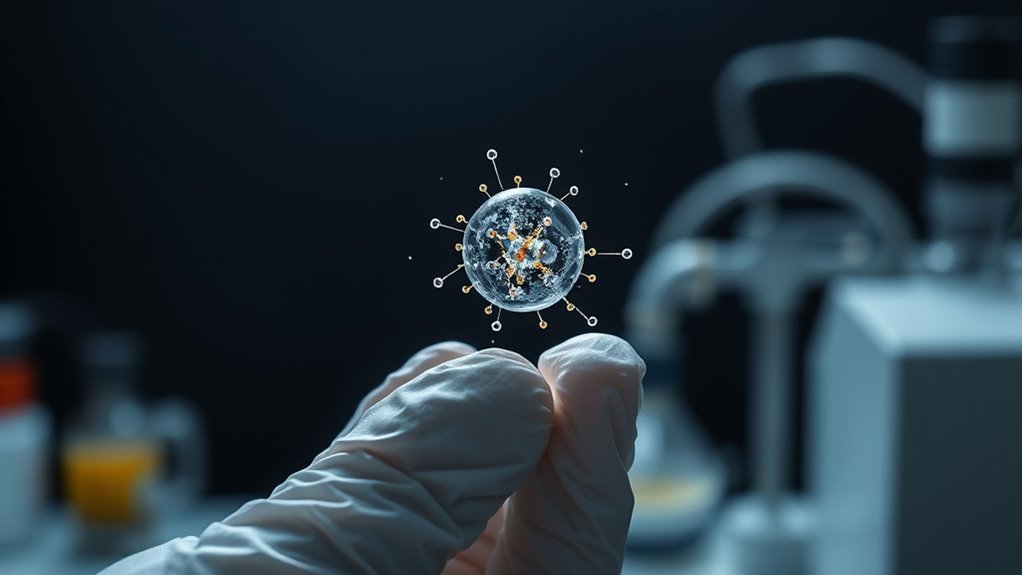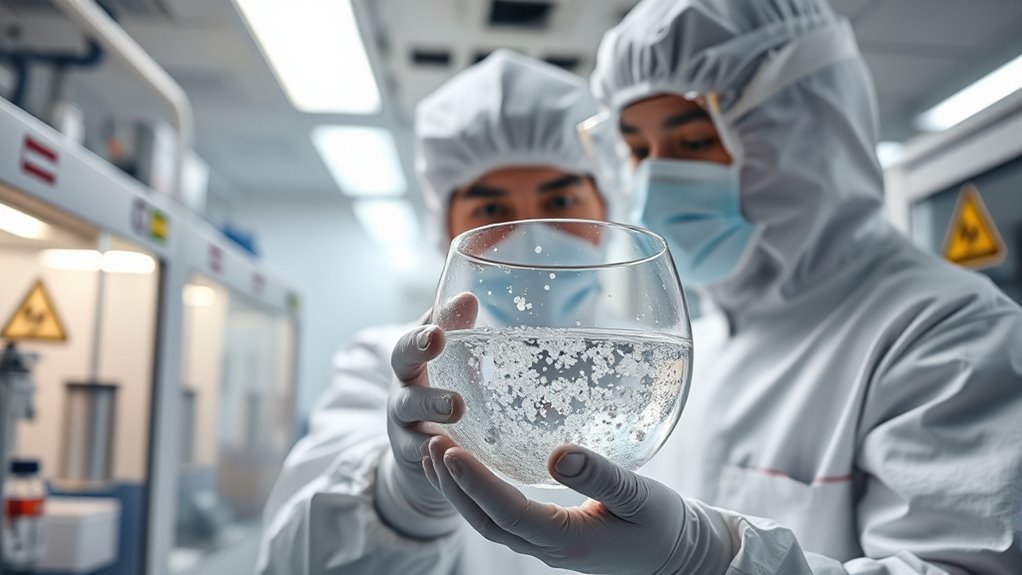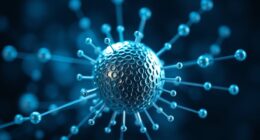Nanomaterials’ tiny size and high reactivity can pose health risks, such as respiratory and skin irritation, and may penetrate biological systems, leading to systemic effects. They also persist in the environment, affecting ecosystems and organisms through bioaccumulation and toxicity. Proper safety measures like PPE, containment, and ventilation are essential to reduce exposure. Balancing benefits with risks requires understanding toxicological mechanisms and responsible innovation—continue exploring to learn how to manage these challenges effectively.
Key Takeaways
- Nanomaterials can penetrate biological systems and the environment, posing risks of toxicity, inflammation, and ecological disruption.
- Inhalation and dermal contact are primary exposure routes, requiring protective equipment and proper handling procedures.
- Persistent nanomaterials may bioaccumulate and induce oxidative stress in organisms, affecting ecosystems over the long term.
- Regulatory frameworks and safety standards are essential to assess hazards, ensure responsible use, and prevent environmental and health risks.
- Developing standardized testing, lifecycle assessments, and green synthesis strategies can mitigate hazards and promote nanomaterial safety.
Understanding Nanomaterials and Their Unique Properties

Nanomaterials are materials engineered at an incredibly small scale, typically less than 100 nanometers in size. Because of their tiny dimensions, they exhibit unique physical, chemical, and biological properties that differ from bulk materials. For example, nanomaterials often have increased surface area, making them more reactive and stronger. You’ll notice they can be transparent, lightweight, and better at conducting heat or electricity. These properties enable their use in various industries, from medicine to electronics. Their small size also allows them to penetrate biological systems more easily, which can enhance their performance but also raises safety concerns. Understanding these distinctive traits helps you grasp why nanomaterials are both promising and potentially risky, requiring careful evaluation of their impacts. Additionally, the AROEVE Air Purifier technology highlights how engineering at small scales can improve air filtration efficiency, exemplifying the potential benefits and risks associated with nanomaterials.
Potential Human Health Risks Associated With Nanomaterials

You need to contemplate how inhaling nanomaterials might pose respiratory risks, especially as these particles can reach deep into your lungs. Skin contact with nanomaterials could lead to absorption or irritation, raising safety concerns. Additionally, systemic toxicity is possible if nanomaterials enter your bloodstream, potentially affecting your organs and overall health. Understanding the self watering plant pots design can illustrate how nanomaterials might migrate through different environments if improperly managed.
Inhalation and Respiratory Risks
How significant are the inhalation and respiratory risks posed by nanomaterials to human health? These tiny particles can penetrate deep into your lungs, reaching the alveoli where gas exchange occurs. Once inhaled, nanomaterials may cause inflammation, oxidative stress, or damage to lung tissues, potentially leading to respiratory issues like asthma or chronic bronchitis. Certain nanomaterials, especially those with high reactivity or small size, pose greater risks because they can cross biological barriers and enter your bloodstream. Workers handling nanomaterials without proper protective equipment face increased exposure. While research is ongoing, current evidence suggests inhalation remains a primary concern. Minimizing inhalation risks involves using proper ventilation, protective masks, and safe handling procedures to prevent respiratory health issues.
Skin Contact Concerns
Although skin contact with nanomaterials may seem less immediate than inhalation risks, it can still pose significant health concerns. Nanoparticles can penetrate the outer skin layer, especially if the skin is damaged or compromised, leading to localized irritation or inflammation. Certain nanomaterials may also bind to skin proteins, potentially triggering allergic reactions or sensitization over time. Repeated or prolonged exposure increases the chance of absorption, raising concerns about systemic effects. Even if the skin acts as a barrier, nanoparticles’ small size allows them to slip through pores or hair follicles. Handling nanomaterials without proper protective gear heightens the risk. Silicone and other materials in skin-contact products may also influence nanoparticle absorption, increasing potential health hazards. Hence, it’s essential to use appropriate gloves and protective clothing to minimize direct skin contact and reduce potential health hazards.
Systemic Toxicity Potential
While skin contact with nanomaterials may pose localized risks, their small size also raises concerns about systemic toxicity. Because nanomaterials can penetrate biological barriers, they might enter your bloodstream, reaching organs and tissues. Once inside, they could induce inflammation, oxidative stress, or cellular damage, potentially leading to long-term health issues. Their ability to translocate across biological barriers depends on factors like size, shape, and surface chemistry. If inhaled or ingested, nanomaterials might accumulate internally, increasing the risk of toxicity. Although research is ongoing, current evidence suggests that systemic exposure could pose significant health threats, especially with repeated or high-level contact. Consequently, understanding their translocation pathways and biological interactions is vital for evaluating human health risks.
Toxicological Mechanisms and Safety Assessment Methods

Understanding how nanomaterials interact with cells is vital for evaluating their safety, especially through cellular interaction pathways. You should also consider how standardized toxicity testing helps guarantee consistency and reliability in safety evaluations. These methods are essential for accurately identifying potential risks associated with nanomaterials. Additionally, implementing AI security strategies can improve the detection of hazardous interactions and ensure more comprehensive safety assessments.
Cellular Interaction Pathways
Cellular interaction pathways determine how nanomaterials enter and affect cells, playing a crucial role in evaluating their safety. You need to understand these pathways to predict potential toxic effects accurately. Nanomaterials can penetrate cells through various mechanisms, including endocytosis, passive diffusion, or membrane fusion. Once inside, they may localize in specific organelles, triggering biological responses. Recognizing these pathways helps you assess risks effectively. Key points include:
- Endocytosis, where cells actively engulf nanomaterials
- Passive diffusion, allowing particles to slip through membranes
- Organelle targeting, leading to potential cellular damage
- Spiritual practices like meditation and prayer can influence mental resilience, which may impact cellular health through stress reduction mechanisms.
Standardized Toxicity Testing
Standardized toxicity testing provides a systematic framework to evaluate how nanomaterials interact with biological systems and pose potential health risks. It involves using validated protocols and models to assess toxicity endpoints like cytotoxicity, genotoxicity, and oxidative stress. You’ll need to select appropriate assays, such as in vitro cell cultures or in vivo animal models, to generate consistent and comparable data. These tests help identify safe exposure levels and understand mechanisms of toxicity. By following standardized methods, you minimize variability and guarantee reliable results that can inform regulatory decisions. This approach allows you to compare nanomaterials effectively, identify hazards early, and develop safety guidelines. Additionally, implementing cybersecurity measures during data collection and analysis ensures the integrity and confidentiality of sensitive research information. Ultimately, standardized testing is essential for protecting human health and the environment as nanomaterials continue to advance.
Environmental Persistence and Ecotoxicity of Nanoparticles

Nanoparticles often persist in the environment longer than their bulk counterparts, raising concerns about their long-term ecological impacts. Because of their small size and high reactivity, they can accumulate in soil, water, and organisms, potentially disrupting ecosystems. Their ecotoxicity depends on factors like composition, shape, and surface chemistry, which influence interactions with flora and fauna. You should be aware that:
- Nanoparticles can bioaccumulate, affecting food chains.
- They may induce oxidative stress in aquatic organisms.
- Environmental transformations can alter their toxicity and mobility.
- Environmental persistence of nanoparticles significantly influences their potential environmental risks.
Understanding their persistence helps predict potential risks, but it also highlights the need for careful assessment of nanoparticle stability and behavior in different environments. Managing their environmental impact requires ongoing research into their long-term ecological effects.
Exposure Routes and Occupational Safety Measures

You need to understand the main exposure routes when working with nanomaterials to stay safe. Controlling inhalation risks, preventing skin contact, and following proper handling and storage protocols are essential. Implementing these safety measures helps protect you from potential health hazards. Awareness of toxicology data is crucial for assessing the risks associated with nanomaterials and ensuring appropriate safety practices.
Inhalation Risks and Controls
Because inhalation is a primary route of exposure to nanomaterials, understanding the associated risks is vital for ensuring safety in occupational settings. Nanoparticles can reach deep into your lungs, potentially causing respiratory issues or other health problems. To minimize inhalation risks, it’s essential to implement proper controls. These include:
- Using local exhaust ventilation systems to capture airborne particles
- Wearing well-fitted respirators designed for nanoparticle protection
- Maintaining good work practices, such as avoiding the generation of dust clouds
- Recognizing the importance of Best Anime Movies and other diverse content for stress relief and mental well-being.
Dermal Exposure Prevention
Since dermal contact is a common route of exposure to nanomaterials in the workplace, implementing effective safety measures is crucial to prevent skin absorption and irritation. You should wear appropriate personal protective equipment, such as chemical-resistant gloves and full-body protective clothing, to create a barrier against nanomaterials. Regularly inspect PPE for damage and replace it as needed. Utilize work practices that minimize skin contact, like using tools or barriers instead of direct handling. Wash your hands and exposed skin promptly after handling nanomaterials, avoiding contaminated clothing. Maintain cleanliness in your workspace by cleaning surfaces and equipment thoroughly. Training on safe handling procedures and awareness of potential skin hazards is essential to ensure your safety and reduce the risk of dermal exposure. Understanding the importance of local tips and safety awareness can significantly enhance your protective measures.
Handling and Storage Protocols
Proper handling and storage of nanomaterials are essential to minimize exposure risks in the workplace. You should always use appropriate containment measures, such as sealed containers and fume hoods, to prevent accidental release. Label all storage areas clearly to avoid mishandling and ensure staff awareness. Store nanomaterials separately from other chemicals to prevent cross-contamination. Additionally, follow these safety practices:
- Wear personal protective equipment (PPE), including gloves, masks, and goggles, during handling.
- Keep storage areas clean, well-ventilated, and equipped with spill cleanup supplies.
- Limit access to trained personnel only, and implement strict protocols for transfer and disposal.
Regulatory Frameworks and Guidelines for Nanomaterial Use

Regulatory frameworks and guidelines for nanomaterial use are vital to guarantee their safe development and application. They establish standards for testing, characterization, and risk assessment, helping you identify potential hazards early. Agencies like the EPA, FDA, and OECD have developed specific protocols to evaluate nanomaterials’ toxicity and environmental impact. These regulations aim to ensure transparency, accountability, and consistent safety measures across industries. You must adhere to labeling requirements, safety data sheets, and disposal procedures to minimize risks. Although regulations are evolving, they provide a fundamental foundation for responsible innovation. By following these guidelines, you can help prevent adverse health and environmental effects while supporting the advancement of nanotechnologies in a safe and sustainable manner.
Strategies for Safe Design and Responsible Innovation

To promote safe design and responsible innovation in nanomaterials, you need to integrate safety considerations early in the development process. This proactive approach helps identify potential risks before they escalate. You should adopt a risk-based design strategy, prioritize green synthesis methods, and incorporate safety assessments throughout development. Focus on minimizing hazardous exposures by selecting safer raw materials and designing for easier disposal or recycling. Collaborate with multidisciplinary teams to evaluate environmental impacts and toxicity potential from the start. Additionally, stay informed about evolving regulations and best practices. By embedding safety into your innovation process, you not only protect users and the environment but also foster sustainable growth in nanotechnology. Remember, responsible innovation is key to *accessing* nanomaterials’ full potential safely.
Case Studies of Nanomaterial Incidents and Lessons Learned

Real-world incidents involving nanomaterials highlight the importance of learning from past mistakes to improve safety practices. For example, in one case, workers exposed to poorly contained silver nanoparticles experienced respiratory irritation, revealing gaps in handling procedures. Another incident involved accidental release of carbon nanotubes into the environment, raising concerns about ecological impacts. These events underscore the need for strict containment, proper protective equipment, and robust risk assessments. Lessons learned include the importance of thorough hazard communication, real-time monitoring, and emergency response plans. By studying these incidents, you can identify vulnerabilities in safety protocols and implement preventive measures. These case studies serve as critical reminders that proactive risk management and continuous safety training are essential to minimize harm and protect both workers and the environment.
Future Directions in Risk Assessment and Management

Building on lessons from past incidents, advancing risk assessment and management strategies is essential to safely harness nanomaterials’ potential. Future efforts should focus on developing standardized testing protocols that ensure consistency across studies. Incorporating predictive modeling and high-throughput screening can help identify hazards early, reducing uncertainties. Additionally, adopting a lifecycle approach will address risks from production to disposal, promoting sustainable practices. You should also prioritize transparency and stakeholder engagement to build trust and facilitate informed decision-making. Emphasizing real-world exposure scenarios will improve relevance, while interdisciplinary collaboration will foster innovative solutions. By refining these strategies, you’ll better anticipate risks and implement controls that protect health and the environment, ensuring nanomaterials’ benefits are realized responsibly.

As nanomaterials advance rapidly, balancing innovation with safety requires careful ethical and social consideration. You need to evaluate how these technologies impact society, ensuring they benefit everyone without causing harm. Transparency is critical; keep the public informed about potential risks and benefits. You should also consider equity, making sure access isn’t limited to a privileged few and preventing disparities. Respect for privacy and consent is essential, especially with nanotech’s potential in medicine and surveillance. Engaging diverse stakeholders helps identify concerns early and develop responsible guidelines. Ultimately, fostering trust depends on balancing progress with caution, so you can innovate responsibly while safeguarding health, environment, and societal values. This approach ensures that nanotechnology advances serve the greater good without compromising safety or ethics.
Frequently Asked Questions
How Do Nanomaterials Interact With Biological Systems at the Molecular Level?
You observe that nanomaterials interact with biological systems at the molecular level by penetrating cell membranes due to their small size, then binding to proteins, DNA, or other cellular components. This can alter normal functions, trigger immune responses, or cause toxicity. Their high surface area allows for reactive surfaces, making interactions more intense. As a result, these interactions can be both beneficial for medical applications and risky if toxic effects occur.
What Are the Long-Term Environmental Effects of Nanoparticle Accumulation?
You might not immediately notice, but nanoparticle accumulation can have lasting environmental effects. Over time, these particles build up in soil and water, potentially harming ecosystems and wildlife. They may alter nutrient cycles, damage aquatic life, or even enter the food chain. Your actions, like proper disposal and supporting green technologies, can help reduce long-term environmental risks associated with nanoparticle buildup, safeguarding ecosystems for future generations.
Are There Any Known Safe Alternatives to Hazardous Nanomaterials?
Yes, there are safe alternatives to hazardous nanomaterials, and you can choose biodegradable polymers, naturally derived nanomaterials, and green synthesis methods. These options reduce toxicity, environmental impact, and health risks. By focusing on eco-friendly, biocompatible, and sustainable materials, you can develop safer products. Prioritizing these alternatives helps protect ecosystems, minimize human exposure, and promote responsible innovation in nanotechnology.
How Can Public Awareness Influence Nanomaterial Safety Policies?
Your awareness can considerably influence nanomaterial safety policies by prompting policymakers to prioritize transparency and enforce stricter regulations. When you stay informed and voice concerns, you drive industry accountability and push for safer practices. Public pressure encourages research into safer alternatives and better safety standards. By actively engaging and spreading awareness, you help shape policies that protect both health and the environment from potential nanomaterial risks.
What Are the Challenges in Developing Standardized Testing Protocols for Nanotoxicity?
You face challenges in developing standardized nanotoxicity testing protocols because nanomaterials vary widely in size, shape, and composition, making it hard to create universal methods. Additionally, existing tests may not accurately reflect real-world exposure or biological effects. You also need to account for the unique behaviors of nanomaterials in biological and environmental systems, which complicates establishing reliable, reproducible safety assessments across different laboratories and industries.
Conclusion
As you navigate the fascinating world of nanomaterials, remember that safety isn’t just a precaution—it’s your guiding star. By understanding their risks, implementing responsible design, and staying vigilant, you can turn potential hazards into opportunities for innovation. Think of safety measures as your trusty shield—protecting you while you explore endless possibilities. Embrace this balance, and you’ll ensure that progress and responsibility walk hand in hand into a brighter, safer future.









